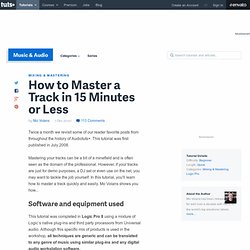

Sphere (Color Theory Visualizer) - StumbleUpon. Musical scale. The frequencies 440Hz and 880Hz both correspond to the musical note A, but one octave apart. The next higher A in the musical scale would have the frequency 1760Hz, twice 880Hz. In the western musical scale, there are 12 notes in every octave. These notes are evenly distributed (geometrically), so the next note above A, which is B flat, has frequency 440 × β where β is the twelfth root of two, or approximately 1.0595.
The next note above B flat, which is B, has frequency 440 × β 2. Left is a table of the complete musical scale between middle A and A-880. The psychoacoustic properties of the musical scale are fascinating. Frequencies that are harmonically related tend to sound good together. The blue waveform is the sound you hear, which is a combination of the other (pure tone) waveforms. What about 440 × 3 = 1320? For somewhat more arcane reasons, the interval between A and E, which is a frequency rise of 3/2, is called a fifth. Where does the C sharp come from in the major triad? Top 100 Best Acoustic Songs Ever -The Greatest of All Time. Here is a list of the best acoustic songs ever written.

Acoustic music has come a long way over the years, so many are “oldies” and many are “newies.” We are basing this list off of historical album sales, the ever so objective factor of acoustic-ness, but mostly how easily they make us cry. They are mostly arranged in alphabetical order, by song – so make sure you check out the whole list! Feel free to give your input on suggestions, changes, discards, or songs we may have forgot about. Also, for those interested in a serious path to learning guitar, please see our trusted partner, Guitar Tricks: Click the links to listen to the songs. Listen 1-9 Listen 10-19 Listen 20-29 Listen 30-39 Listen 40-49 Listen 50-59 Listen 60-69 Listen 70-79 Listen 80-89 Listen 90-100 **ALPHABETICAL ORDER (Roughly)** 1. 3 AM – Matchbox 20 2. 10,000 Stones – Adrianne 3.
How Franz Liszt Became The World's First Rock Star. Hide caption Illustration of Franz Liszt.

The Hungarian composer and pianist revolutionized the art of performance. Time & Life Pictures/Getty Images Pianist Lang Lang honors his idol on the new album 'Liszt: My Piano Hero.' Purchase Featured Music. How to Master a Track in 15 Minutes or Less. Twice a month we revisit some of our reader favorite posts from throughout the history of Audiotuts+.

This tutorial was first published in July 2008. Mastering your tracks can be a bit of a minefield and is often seen as the domain of the professional. However, if your tracks are just for demo purposes, a DJ set or even use on the net, you may want to tackle the job yourself. In this tutorial, you'll learn how to master a track quickly and easily. Mo Volans shows you how... Software and equipment used This tutorial was completed in Logic Pro 8 using a mixture of Logic’s native plug-ins and third party processors from Universal audio. Step 1 Start by adding a stereo track to accommodate your un-mastered track. To allow maximum flexibility at the mastering stage there should be as little processing as possible taking place on your exported pre-master.
Step 2 Check you have enough headroom for your mastering processors to work in. Step 3. Rainy_evening_1 - StumbleUpon. Query Voice. How to produce great-sounding drum tracks - Gating. This is a part 4 of the tutorial on how to process individual raw drum tracks into finished product.

Make sure to read all the parts. Part 1: Introduction / Approach Part 2: Editing Part 3: Track Time Alignment Part 4: Gating Part 5: EQ Part 6: Phase Alignment Part 7: Compression Part 8: Ambiance (Reverb) Gating is a process in which a processor (a plugin) reduces or completely removes sound under a certain sound level (threshold). We are going to gate snare drum and the kick drum, but using different techniques. Snare Drum Gating We have 2 microphones for the snare: top head and bottom head. Use a sharp low-cut filter (36-42db per octave) and set it around 150Hz. Top Snare Mic: Audio - MASTERING.